We’ve all faced that frustrating challenge of trying to create a lush industry in those stubborn shady areas where grass refuses to grow and bare soil dominates. Whether it’s under towering trees, alongside north-facing walls, or in those dim corners of our yards, these spaces often become neglected eyesores rather than the beautiful garden features they could be.
The secret to transforming these problem areas lies in selecting the right ground cover plants for shade. These remarkable plants don’t just survive in low-light conditions – they actually thrive there, creating dense carpets of foliage that suppress weeds while adding texture and color to forgotten spaces.
We’ll explore the most effective shade-loving ground covers that’ll turn your garden’s challenging spots into stunning focal points. From quick-spreading varieties that’ll fill large areas fast to slower-growing options perfect for smaller spaces, you’ll discover proven answers that work in even the deepest shade conditions.
Why Ground Cover Plants Are Essential for Shady Areas
Shady areas in our gardens present unique challenges that traditional grass simply can’t overcome. We find that most turf varieties require at least 4-6 hours of direct sunlight daily to maintain healthy growth, leaving shadowy spots beneath trees and along north-facing walls struggling with thin, patchy coverage.
Ground cover plants offer specialized answers for these problematic zones by adapting to low-light conditions that would stress conventional lawn grass. These resilient plants develop extensive root systems that prevent soil erosion on slopes and underneath large trees where water runoff commonly occurs during heavy rainfall.
Moisture retention becomes significantly improved when we establish dense ground cover in shaded areas. The living carpet created by these plants acts as natural mulch, reducing water evaporation by up to 70% compared to bare soil surfaces. This moisture conservation proves especially valuable during summer months when competition from tree roots intensifies.
Weed suppression ranks among the most practical benefits we gain from shade-tolerant ground covers. Dense plantings like pachysandra and vinca minor create barriers that block sunlight from reaching weed seeds, reducing unwanted growth by approximately 85% in established areas.
Maintenance requirements drop substantially once ground cover plants establish themselves in shady locations. Unlike grass that demands regular mowing, fertilizing, and overseeding, most shade ground covers require only occasional watering and annual cleanup of dead foliage.
Aesthetic appeal transforms neglected shady corners into attractive garden features through varied textures, seasonal colors, and interesting foliage patterns. Plants such as hostas and heuchera provide striking leaf variations that create visual interest throughout growing seasons when traditional grass would appear thin and unhealthy.
Wildlife habitat expansion occurs naturally when we introduce diverse ground cover species to shaded areas. These plants attract beneficial insects, provide shelter for small creatures, and create ecological niches that support local biodiversity in ways bare or sparse grass coverage cannot match.
Ajuga: The Colorful Carpet Solution
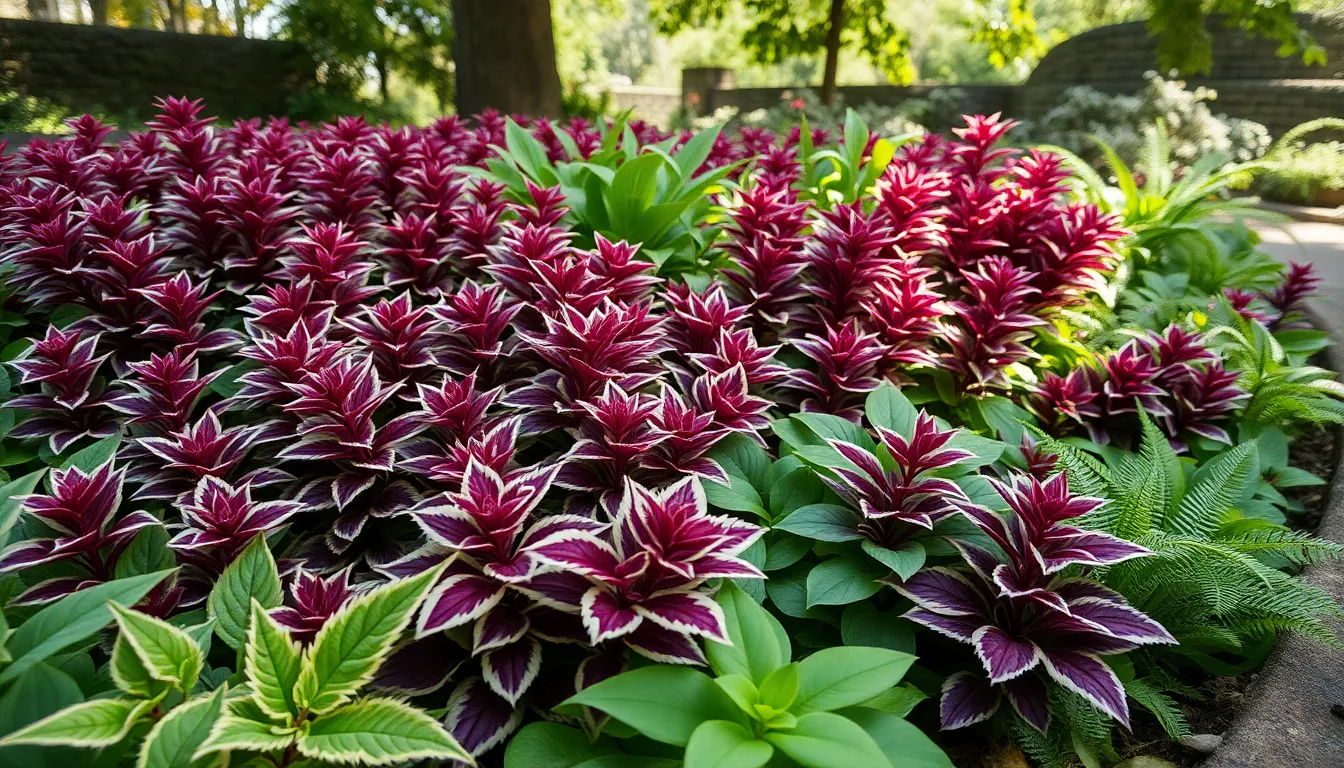
Ajuga transforms challenging shaded areas into vibrant living carpets that thrive where traditional grass fails. We’ve found this versatile ground cover to be one of the most reliable answers for creating dense, colorful coverage in low light conditions.
Purple-Leaved Varieties for Visual Interest
Burgundy Glow cultivars create stunning displays with their maroon and cream edged leaves that maintain color throughout the growing season. We recommend this variety for gardeners seeking maximum visual impact in their shade gardens.
Bronze Beauty selections offer deep bronze purple foliage that intensifies in cooler weather. These varieties provide excellent contrast when planted alongside green leafed hostas or ferns.
Chocolate Chip varieties feature smaller leaves with rich chocolate bronze coloring that works perfectly in tight spaces. We’ve seen these compact forms excel in rock gardens and between stepping stones.
Variegated options like ‘Silver Beauty’ combine green centers with cream margins for bright accents in darker garden areas. These multicolored cultivars help lighten shadowy corners while maintaining the same spreading characteristics as solid colored types.
Purple Torch selections produce the deepest purple foliage we’ve encountered in ajuga varieties. These dramatic plants create bold statements when mass planted in large shade areas.
Spreading Habits and Maintenance Tips
Stolon formation allows ajuga to spread rapidly via underground runners that create new plants every 6 to 8 inches. We’ve observed coverage rates of 2 to 3 feet per year in optimal conditions.
Installation spacing of 12 to 18 inches between plants ensures quick coverage without overcrowding. We place new plants in spring or early fall for best establishment results.
Containment methods include installing plastic or metal edging around planting areas to prevent invasion into lawn spaces. We recommend edging depths of 4 to 6 inches to effectively block stolon spread.
Watering requirements consist of moderate moisture levels with good drainage to prevent root rot issues. We water deeply once weekly during dry periods rather than frequent shallow watering.
Air circulation becomes critical in humid climates where mildew problems can develop on dense foliage. We thin overcrowded areas and avoid overhead watering to maintain plant health.
Pruning schedules involve removing spent flower spikes after blooming and trimming back aggressive growth in late summer. We divide overcrowded clumps every 3 to 4 years to maintain vigor.
Soil preferences include well draining conditions with organic matter additions for best growth results. We’ve successfully grown ajuga in clay, sandy, and loamy soils with pH levels between 6.0 and 7.5.
Pachysandra: The Classic Evergreen Choice
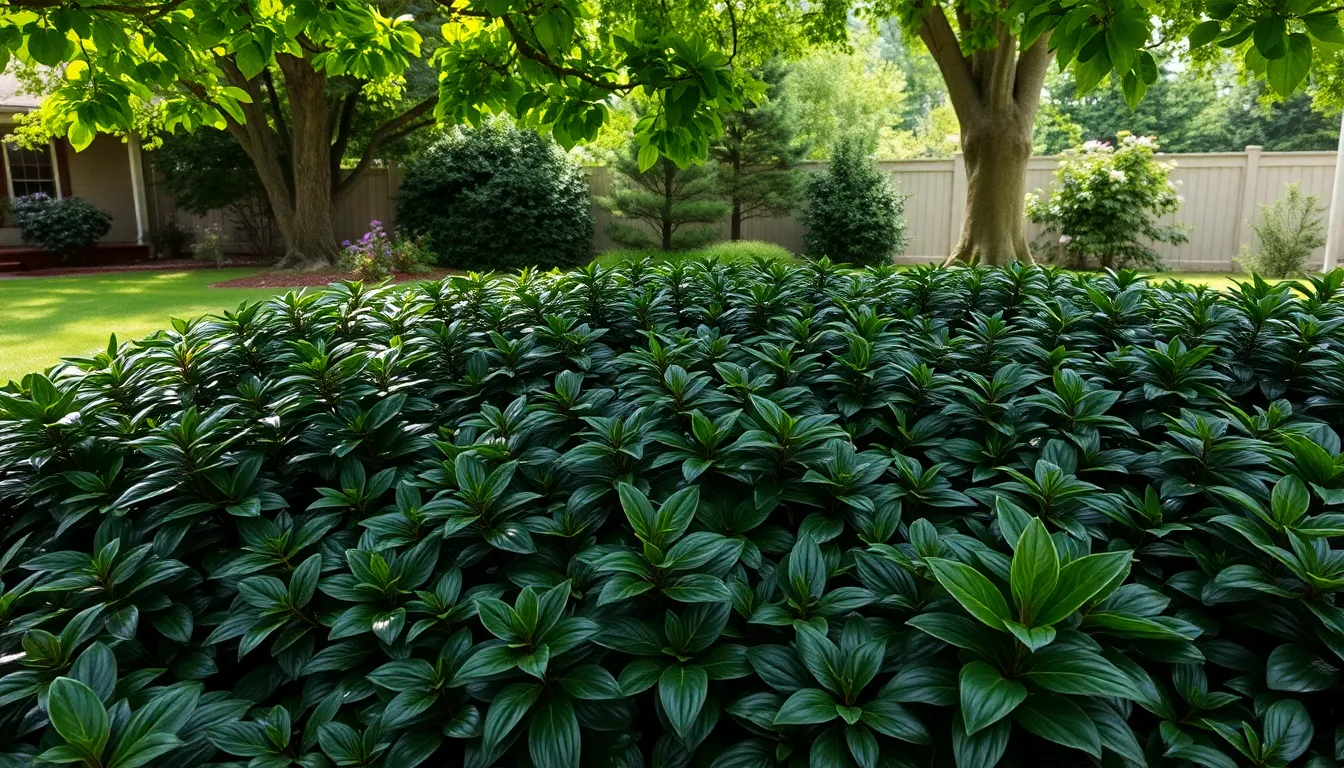
We’ve found that Pachysandra terminalis stands as one of the most reliable ground cover answers for challenging shade gardens. This evergreen perennial creates dense carpets of glossy, dark green leaves that maintain their beauty throughout the year, growing 6 to 12 inches tall while spreading steadily through underground rhizomes.
Japanese vs. Allegheny Pachysandra Differences
Japanese Pachysandra (Pachysandra terminalis) dominates the landscaping market as the go-to variety for shade coverage. Native to Japan and northern China, this species develops thick, glossy leaves with scalloped edges and produces small white flower spikes in early spring. We recommend this variety for its proven reliability in forming dense mats within three years of planting.
Allegheny Pachysandra offers a native alternative for gardeners preferring indigenous plants. This North American species features more delicate foliage with different leaf shapes and growth patterns compared to its Japanese counterpart. While both varieties thrive in shade conditions, Japanese Pachysandra typically provides more consistent, reliable ground coverage for most residential applications.
Growth characteristics differ between these species, with Japanese Pachysandra spreading more aggressively through rhizome systems. Allegheny varieties tend to have a more restrained growth habit, making them suitable for smaller garden spaces or areas where controlled spreading is preferred.
Ideal Growing Conditions and Care
Light requirements for Pachysandra are straightforward: partial to full shade conditions work best. We’ve observed that full sun exposure causes leaf bleaching and wind damage, making shaded locations under trees or along north-facing walls perfect growing spots.
Soil preparation should focus on creating moist, well-drained conditions with high organic content. We recommend amending existing soil with compost before planting, aiming for slightly acidic pH levels that mirror the plant’s natural forest floor habitat.
Spacing guidelines call for placing plants 6 to 12 inches apart during installation. This spacing allows the rhizome system to fill in gaps naturally while preventing overcrowding that can lead to disease issues.
| Care Aspect | Recommendation | Frequency |
|---|---|---|
| Watering | Deep, infrequent watering at soil level | Weekly until established |
| Fertilizing | Organic compost application | Annually in spring |
| Pruning | Remove damaged or diseased foliage | As needed |
| Thinning | Improve air circulation if blight appears | Every 2-3 years |
Watering practices should avoid overhead irrigation to prevent leaf blight diseases. We suggest using soaker hoses or drip irrigation systems that deliver moisture directly to the root zone while keeping foliage dry.
Disease prevention relies heavily on good air circulation between plants. Thinning overcrowded areas helps reduce humidity levels that promote fungal issues, particularly important in humid climates or densely planted areas.
Maintenance requirements remain minimal once Pachysandra establishes its root system. Regular monitoring for leaf blight and occasional removal of damaged foliage represents the primary ongoing care needs for this low-maintenance ground cover option.
Hosta: Bold Foliage for Deep Shade
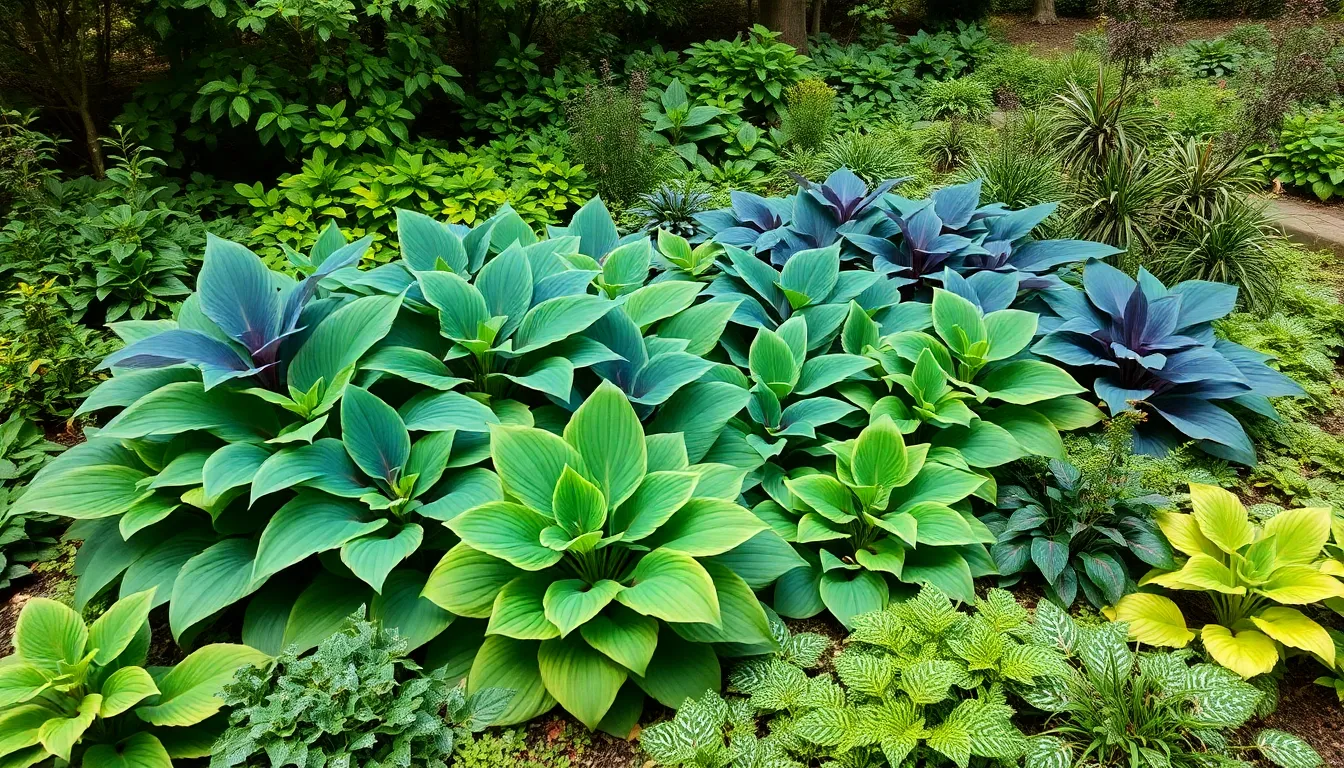
Hostas stand out as one of our most popular ground cover choices for deep shade areas where traditional plants struggle to thrive. These perennial favorites display bold, lush foliage in a wide range of leaf colors, textures, and sizes that create visually striking coverage in the shadiest garden spots.
Miniature Varieties for Small Spaces
Dwarf hostas offer all the charm of their larger cousins while fitting perfectly into compact shade gardens and small borders. These miniature varieties maintain the characteristic bold foliage on a smaller scale, making them ideal for container planting and rock gardens where space is limited.
Space efficiency becomes crucial when we’re working with tight garden areas under trees or alongside pathways. Miniature hostas provide excellent coverage without overwhelming small spaces, delivering the same shade tolerance and aesthetic appeal as full-sized varieties.
Container gardening benefits tremendously from these compact performers, as they adapt well to pots and planters on shaded patios or porches. We can easily move these portable shade answers to optimize their growing conditions throughout the season.
Companion Planting Strategies
Layered textures create visual interest when we combine hostas with other shade tolerant ground covers that vary in height and bloom time. Barrenwort spreads slowly and tolerates dry shade while producing delicate spring flowers that complement hosta foliage beautifully.
Colorful accents come from spotted deadnettle, which offers attractive foliage with vibrant flowers blooming from late spring to mid-summer. This combination provides continuous interest throughout the growing season while maintaining excellent ground coverage.
Fragrant options like sweet woodruff add sensory appeal with white spring flowers and natural deer and rabbit resistance. Bunchberry thrives in cool moist shade, producing white flowers followed by red berries that create seasonal color changes.
Soil health improvement occurs naturally when we use companion planting strategies, as different root systems work together to enhance moisture retention and organic matter distribution. These diverse plantings create sustainable shade gardens that support each other’s growth while reducing maintenance requirements.
Wild Ginger: Native Beauty for Natural Gardens
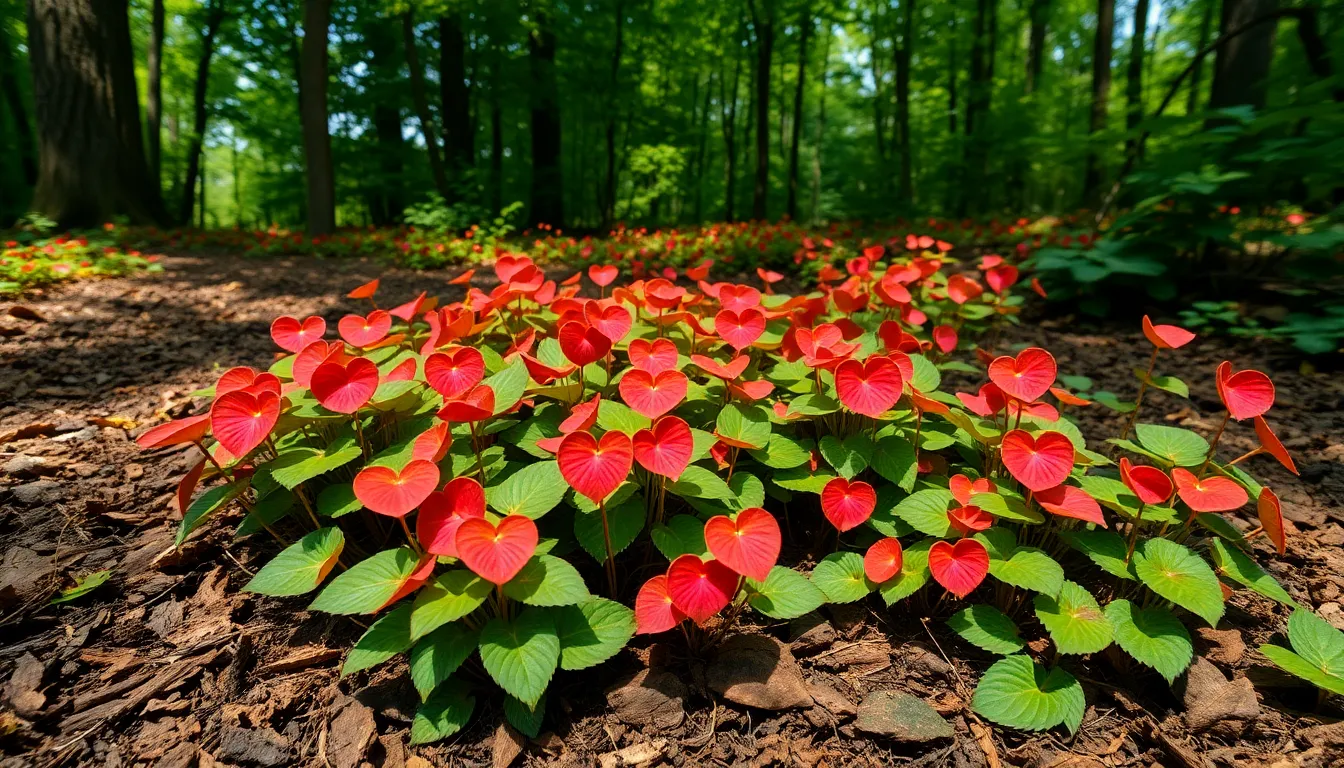
Wild ginger stands out as an exceptional native ground cover that brings authentic woodland beauty to our shade gardens. This naturally occurring plant creates stunning heart-shaped leaf carpets that thrive where traditional grass simply can’t survive.
Soil Requirements and Moisture Needs
Rich organic matter forms the foundation of successful wild ginger cultivation. We recommend amending existing soil with compost or leaf mold to replicate the plant’s natural woodland habitat conditions.
Well-drained yet consistently moist soil provides the ideal growing environment for wild ginger. The plant requires moisture retention without waterlogging, making proper drainage essential for healthy root development.
Acidic to neutral pH levels support optimal growth patterns in wild ginger plantings. We’ve found that soil pH between 5.5 and 7.0 creates the most favorable conditions for establishment and long-term health.
Mulch application around established plants conserves essential moisture while keeping root systems cool during warmer months. This protective layer mimics the natural forest floor environment where wild ginger naturally flourishes.
Winter Hardiness and Seasonal Care
USDA zones 4 through 8 provide suitable climates for wild ginger cultivation, offering excellent cold tolerance across much of the United States. This hardy perennial rebounds reliably each spring after surviving harsh winter conditions.
Minimal maintenance requirements make wild ginger an attractive choice for busy gardeners seeking low-care ground cover answers. We focus our seasonal care on maintaining consistent moisture levels during dry periods throughout the growing season.
Early spring cleanup involves removing old foliage to encourage fresh growth and maintain the plant’s attractive appearance. This simple task promotes vigorous new leaf development while preventing disease issues.
Slow spreading characteristics require occasional division every few years to maintain plant vigor and encourage expansion. We recommend dividing established clumps during early spring or fall when plants are less stressed by heat.
Drought monitoring becomes crucial during extended dry spells when supplemental watering supports healthy growth. Wild ginger’s shallow root system depends on consistent moisture availability for optimal performance in shade garden settings.
Lamium: Variegated Leaves with Delicate Flowers
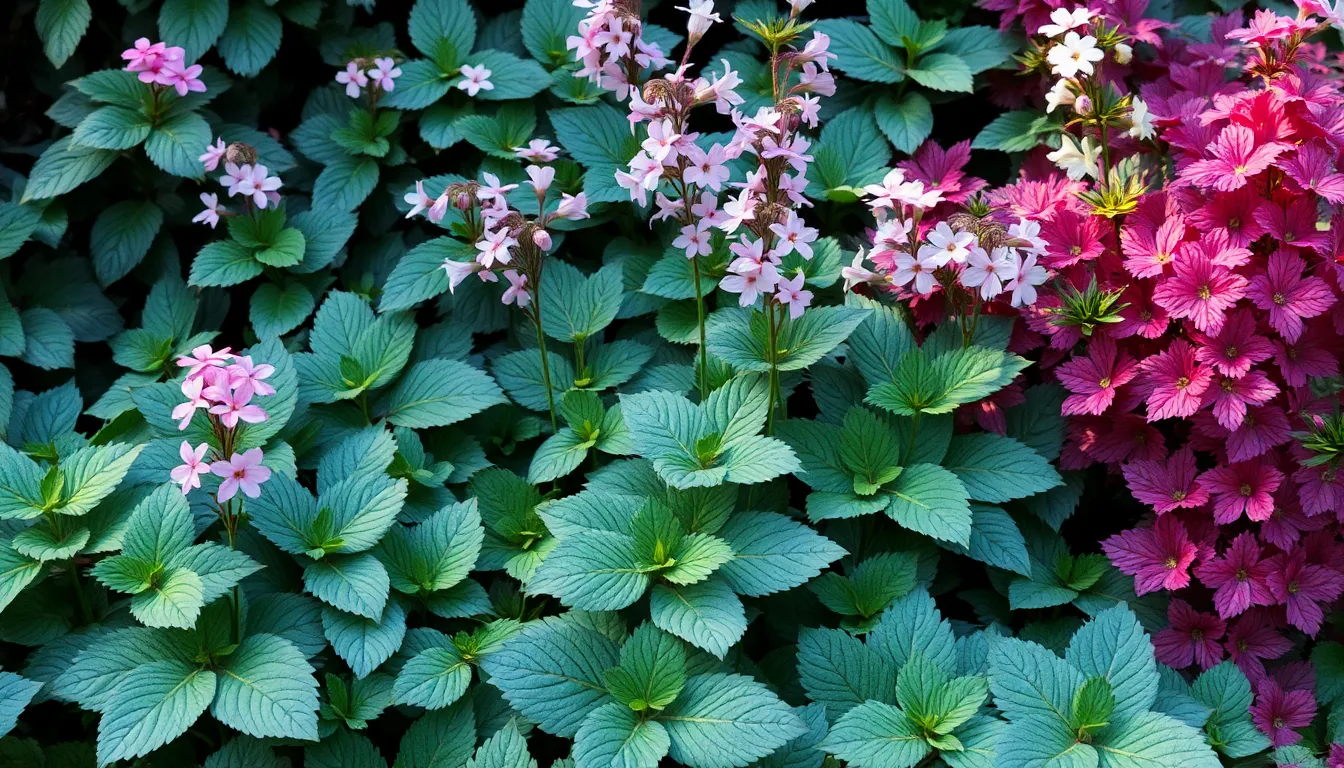
Lamium brings exceptional beauty to shaded garden spaces with its distinctive silver-marked foliage and charming seasonal blooms. We’ve found these versatile perennials excel where other ground covers struggle, creating stunning carpets in areas receiving limited sunlight.
Silver-Leafed Cultivars for Bright Accents
Silver-leafed Lamium cultivars transform dark garden corners into luminous focal points that catch every ray of available light. Popular varieties like ‘Beacon Silver’, ‘Pink Pewter’, and ‘White Nancy’ showcase striking silver leaves with narrow green margins, creating dramatic contrast against darker shade plants. These cultivars typically reach 8 to 12 inches in height while spreading efficiently across partial shade areas.
Spotted deadnettle (Lamium maculatum) produces delicate flowers in pink, purple, or white shades from late spring through mid-summer, adding seasonal color above the reflective foliage. Yellow archangel (Lamium galeobdolon) offers different appeal with cultivars like ‘Variegatum’ and ‘Herman’s Pride’ featuring green leaves adorned with silver markings and bright yellow spring flowers. Growing slightly taller at 2 to 15 inches, yellow archangel adapts well to various shade conditions and tolerates dry soil better than its spotted cousin.
Reflective qualities of silver foliage make these plants invaluable for brightening dim spaces beneath trees and shrubs. We recommend positioning silver-leafed varieties strategically to maximize their light-catching abilities and create visual depth in layered plantings.
Controlling Spread in Garden Beds
Spreading habits of Lamium require thoughtful management to prevent unwanted garden takeover while maintaining desired coverage. These plants expand through underground stems and self-seeding, making them efficient weed suppressors but potentially aggressive in mixed borders. Yellow archangel particularly tends toward invasive behavior if left unchecked in favorable conditions.
Physical barriers work effectively to contain Lamium within designated areas, using buried edging or natural boundaries like walkways and driveways. Regular pruning helps control expansion while encouraging denser growth within desired zones. We suggest removing flower heads before seed set to prevent unwanted spreading through self-seeding.
Monitoring growth patterns allows gardeners to address spreading issues before they become problematic. Dense plantings benefit from periodic thinning to improve air circulation and prevent overcrowding of companion plants. Strategic placement away from delicate perennials protects slower-growing species from being overwhelmed by Lamium’s vigorous growth habit.
Sweet Woodruff: Fragrant Ground Cover with Star-Shaped Leaves
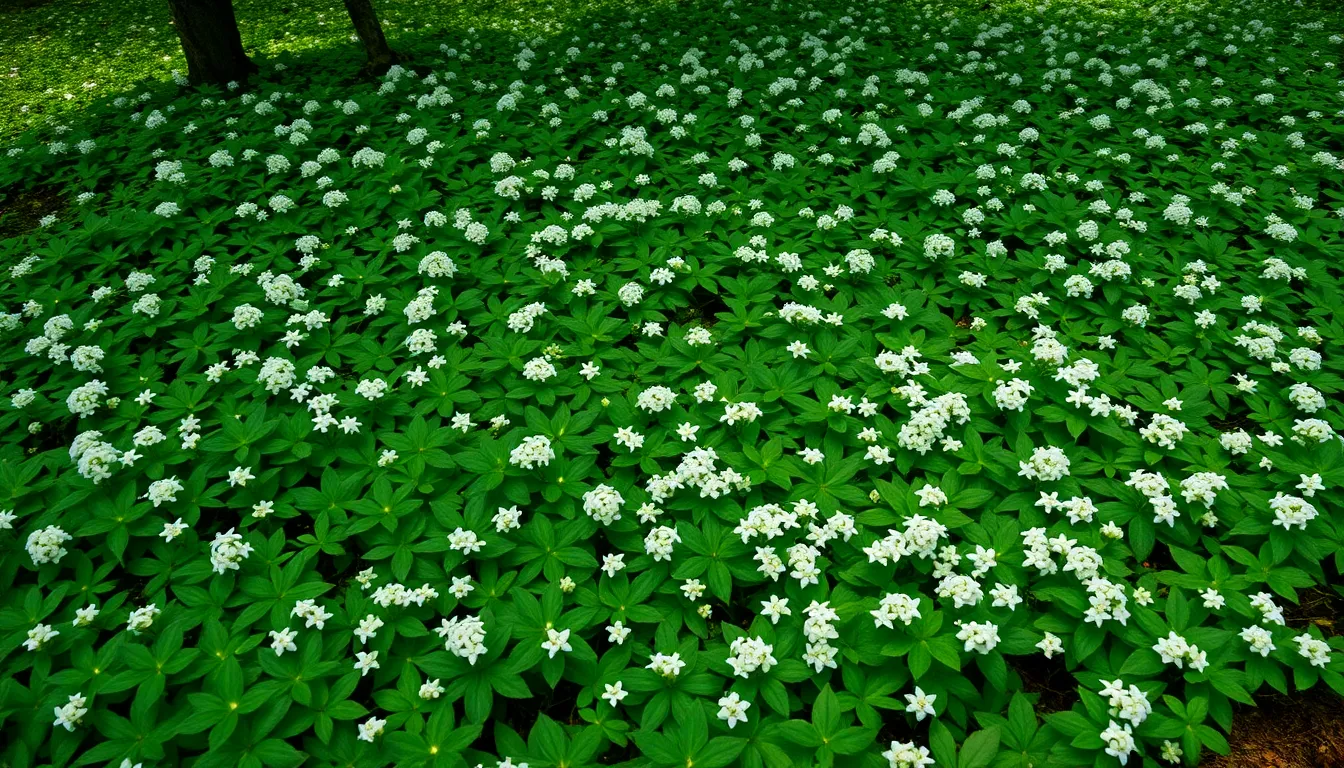
Sweet Woodruff transforms shaded areas into fragrant carpets of delicate beauty, offering gardeners a uniquely aromatic ground cover solution. Galium odoratum creates dense mats of star-shaped leaves that release a sweet, hay-like fragrance when dried or disturbed.
Traditional Uses and Garden Applications
Europeans have treasured Sweet Woodruff for centuries as both a medicinal herb and natural air freshener, incorporating its sweet scent into their daily lives. Beverages and desserts still feature this aromatic plant in traditional European recipes, adding a distinctive floral note to culinary creations.
Garden applications showcase Sweet Woodruff’s exceptional shade tolerance, thriving in partial to full shade where other plants struggle. Moist, well-drained soils provide the ideal foundation for this perennial’s spreading rhizomes to establish dense coverage. Weed suppression becomes effortless as the plant forms thick mats that block light from reaching unwanted seeds below.
Soil erosion prevention ranks among Sweet Woodruff’s most practical benefits, particularly on slopes and beneath trees where rainfall can wash away exposed earth. Shaded borders come alive with this ground cover’s fine textured foliage, while woodland gardens gain authentic character from its naturalistic growth pattern.
Pathways through shaded areas benefit from Sweet Woodruff’s low maintenance requirements and moderate spreading habit. Spring brings clusters of tiny white flowers that complement the plant’s aromatic qualities, attracting early season pollinators to your garden.
Companion Plants and Design Ideas
Layered textures emerge when we combine Sweet Woodruff with other shade-tolerant companions like Barrenwort, Spotted Deadnettle, and Allegheny Pachysandra. Visual interest increases dramatically as these plants offer contrasting leaf shapes, colors, and bloom times throughout the growing season.
| Plant Name | Growth Habit | Shade Tolerance | Notable Features |
|---|---|---|---|
| Sweet Woodruff | Low, spreading mat | Partial to full shade | Star-shaped leaves, fragrant flowers |
| Barrenwort (Epimedium) | Clumping, slow spread | Partial to heavy shade | Heart-shaped leaves, spring flowers |
| Spotted Deadnettle (Lamium) | Low spreading | Partial shade | Variegated foliage, colorful flowers |
| Allegheny Pachysandra (Pachysandra procumbens) | Clumping, slow spread | Full to dappled shade | Seasonal foliage color changes, fragrant flowers |
Design combinations flourish when Sweet Woodruff’s fine textured foliage contrasts with Barrenwort’s broader heart-shaped leaves. Silver variegated Spotted Deadnettle creates striking color combinations against Sweet Woodruff’s solid green backdrop, while both plants share similar moisture requirements.
Naturalistic woodland gardens showcase Sweet Woodruff’s authentic character, particularly when planted beneath deciduous trees where dappled light filters through the canopy. Rock gardens in shaded locations benefit from this ground cover’s ability to soften hard edges while providing fragrant interest.
Spring bulb combinations work exceptionally well with Sweet Woodruff, as the ground cover’s foliage remains attractive long after bulb flowers fade and die back. Sensory elements enhance garden experiences as visitors brush against the fragrant leaves, releasing the plant’s characteristic sweet scent into the air.
Creeping Phlox: Spring Blooms in Partial Shade
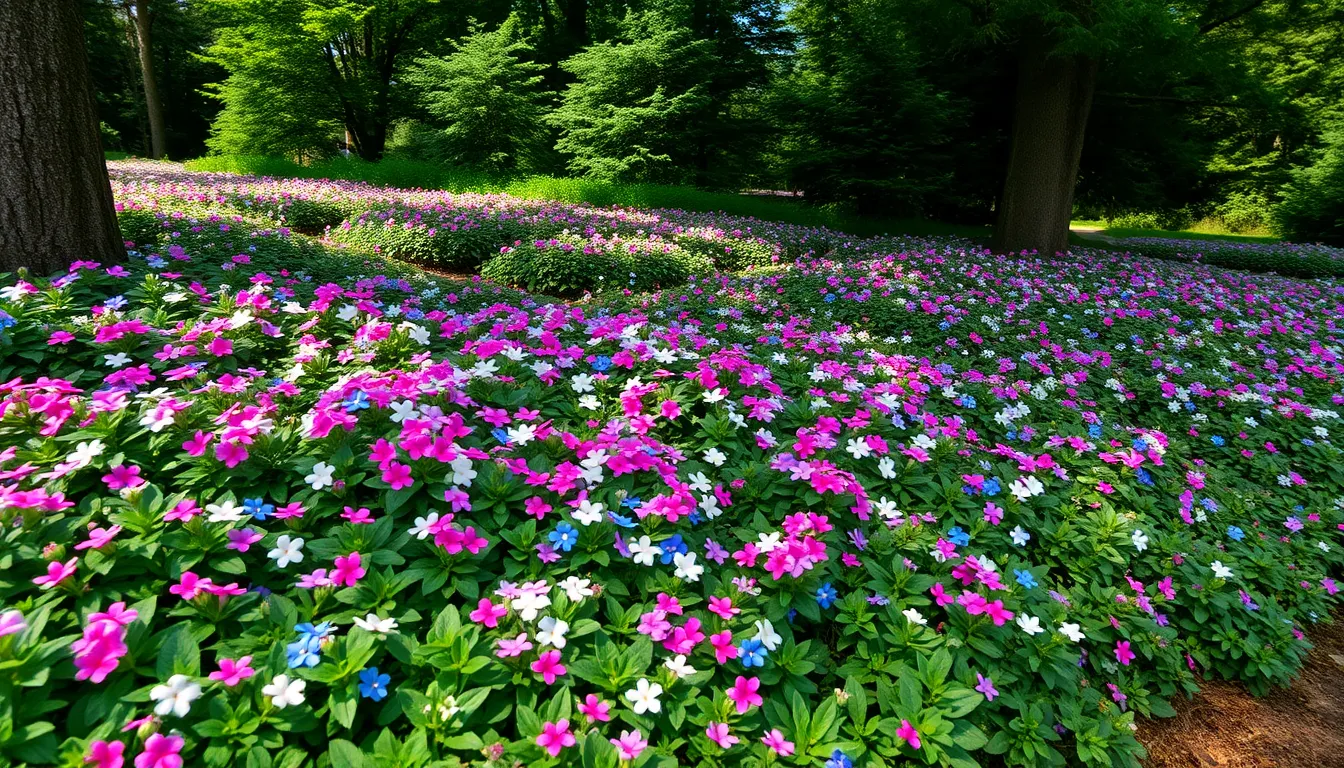
Creeping phlox offers gardeners an excellent transition from traditional shade ground covers to plants that can handle variable light conditions. We’ve found this versatile perennial creates stunning spring displays even in areas with limited sunlight.
Color Variations and Bloom Times
Creeping phlox cultivars provide an impressive spectrum of colors that brighten partial shade areas during early to mid spring. Pink varieties like deep rose and light blush create warm accents against darker garden backgrounds. Purple cultivars offer rich lavender and deep violet tones that complement other shade loving plants beautifully. White selections provide bright contrast in dim areas while blue varieties add cool sophistication to woodland settings.
Bi colored cultivars extend our design possibilities with combinations like white centers surrounded by pink edges. These multi toned flowers create visual depth that’s particularly effective in partially shaded locations. Spring blooming typically lasts several weeks, with some cultivars starting slightly earlier or later depending on microclimate conditions and shade intensity.
The star shaped flowers form dense carpets that cover evergreen needle like foliage completely during peak bloom. We notice that partial shade locations produce somewhat fewer flowers than full sun areas, but the display remains ornamentally important and garden worthy.
Establishing and Maintaining Coverage
Creeping phlox establishes through spreading low stems that root as they travel, creating dense evergreen mats over time. Well drained soil with added organic matter provides the best foundation, especially in shaded environments where moisture retention becomes more critical. The root systems spread horizontally rather than deeply, making surface soil quality particularly important.
Installation spacing of 12 to 18 inches apart allows plants to fill in naturally within two growing seasons. We recommend planting in spring or early fall to give roots time to establish before extreme weather conditions. Initial watering should keep soil consistently moist but never waterlogged, particularly important in shade where air circulation may be reduced.
Maintenance requirements stay minimal once established, with deadheading spent flowers encouraging tidier appearance and potentially extending bloom time. Post flowering trimming in late spring helps maintain dense coverage and prevents the center of clumps from becoming woody. Good airflow and moderate sunlight exposure prevent rot and fungal diseases that can affect plants in heavily shaded, humid conditions.
For deeper shade situations, we suggest considering barrenwort, spotted deadnettle, or Vancouveria species instead, as these alternatives adapt better to consistently low light environments with their specialized shade tolerance mechanisms.
Vinca Minor: Low-Maintenance Periwinkle
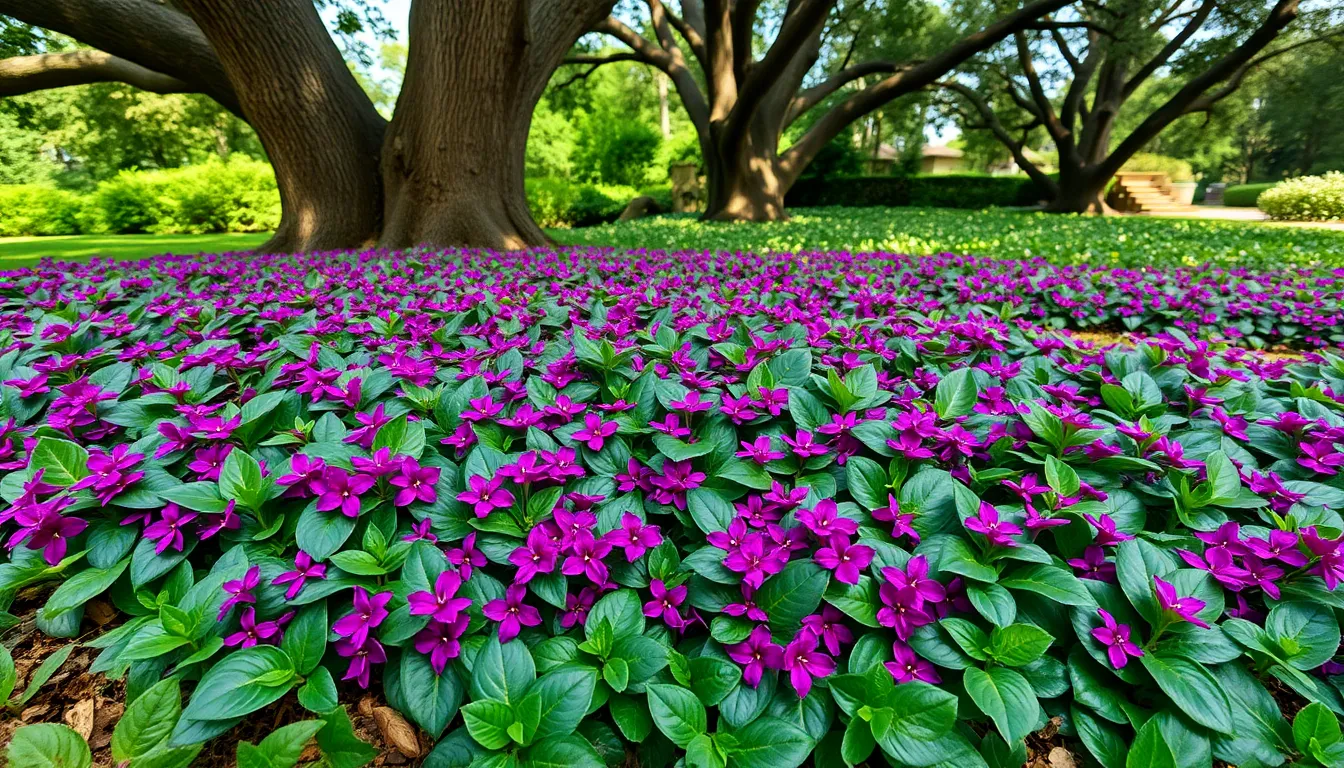
We’ve found Vinca minor to be one of our most reliable ground covers for challenging shade conditions, offering glossy dark green evergreen foliage that spreads steadily without overwhelming nearby plants.
Drought Tolerance Once Established
Vinca minor develops impressive resilience to dry conditions once its root system establishes, typically within the first growing season. Although this periwinkle prefers moist, well-drained soils initially, it exhibits good drought tolerance that makes it suitable for areas with intermittent dry periods. The plant’s adaptability to both shade and drought stress contributes significantly to its popularity among gardeners seeking low-maintenance answers.
We recommend providing consistent moisture during the establishment phase, then gradually reducing watering frequency as the plant matures. This drought tolerance becomes particularly valuable in shaded areas under large trees where competition for water is intense. The combination of shade tolerance and drought resistance makes Vinca minor an excellent choice for difficult garden spots that challenge other ground covers.
Preventing Invasive Spread
Vinca minor requires mindful management to prevent unwanted invasive spread, even though its many beneficial qualities as a ground cover. The plant’s trailing runners root easily at nodes and can spread widely if left unchecked, potentially escaping into natural woodland areas. Regular monitoring and trimming of runners helps maintain desired boundaries and prevents aggressive expansion beyond intended areas.
We suggest installing physical barriers like edging strips or root barriers to limit spread in sensitive locations. Avoiding planting near natural woodlands protects native ecosystems from potential invasion. Choosing less aggressive varieties and combining Vinca minor with native plants helps maintain ecological balance while still enjoying its ground cover benefits.
| Management Strategy | Frequency | Purpose |
|---|---|---|
| Monitor runners | Monthly | Detect unwanted spread |
| Trim excess growth | 2-3 times per season | Control boundaries |
| Remove rooted runners | As needed | Prevent establishment |
| Check barriers | Seasonally | Maintain containment |
The plant’s slow growth rate compared to other ground covers reduces aggressive spreading tendencies, making it a less invasive option when properly managed. This characteristic allows gardeners to enjoy Vinca minor’s benefits while maintaining control over its expansion patterns.
Coral Bells: Ornamental Foliage Year-Round
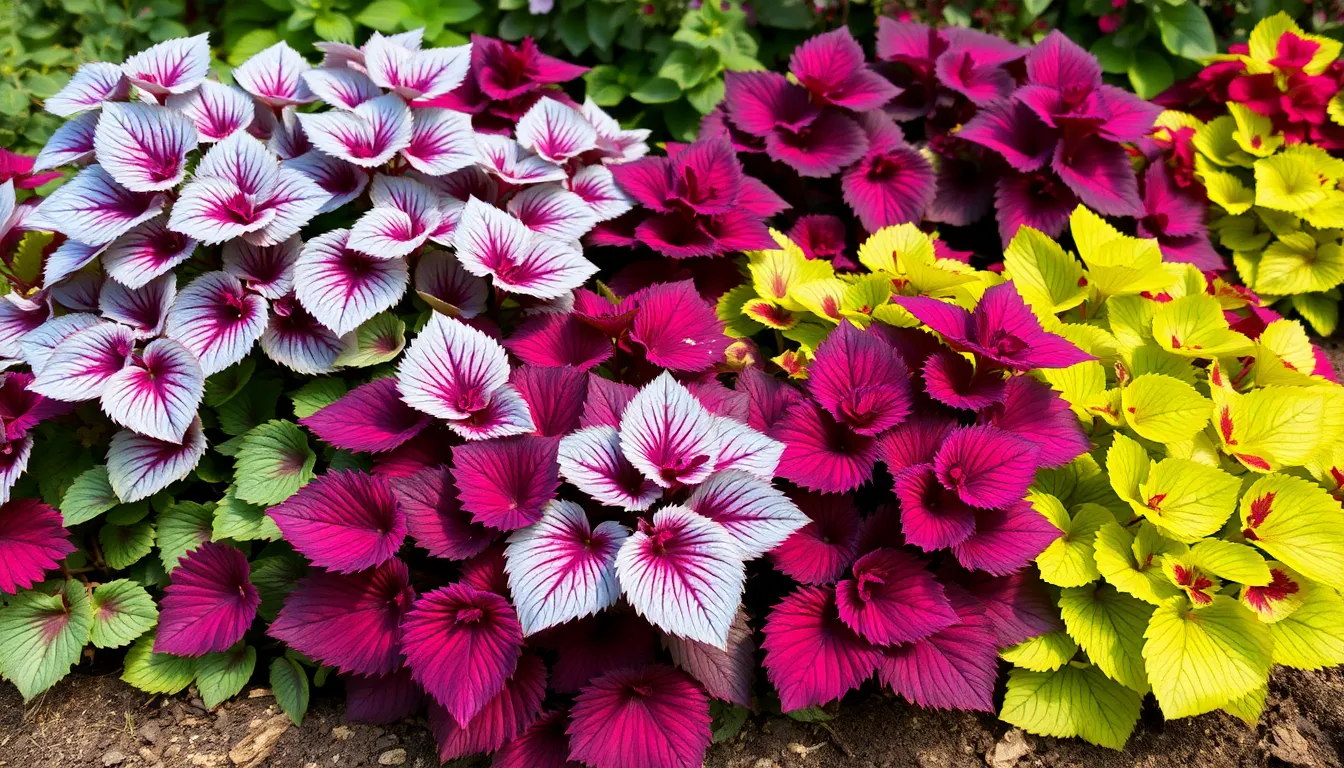
Coral Bells (Heuchera) stand out as exceptional ground cover plants that deliver continuous visual interest throughout all seasons. We’ve found these versatile perennials offer vibrant, multi-colored leaves in nearly every shade from silver to deep purples and almost black, creating stunning displays even during winter months.
Heat-Tolerant Varieties for Warmer Climates
Heucheras demonstrate remarkable adaptability across USDA zones 4-9, making them suitable for diverse climate conditions including intense heat and humidity. We recommend selecting cultivars specifically bred for heat tolerance when gardening in warmer regions, as these varieties maintain their vibrant foliage colors without fading or scorching.
Standard varieties thrive with some morning sun but perform exceptionally well in partial to full shade environments. Gardeners in hot climates should focus on providing adequate moisture and improving soil drainage to prevent root rot during humid periods. Amending heavy clay soils with organic matter or creating raised beds significantly improves growth performance in challenging warm weather conditions.
Heat-resistant cultivars maintain their ornamental appeal even when temperatures soar, though we suggest monitoring soil moisture levels more frequently during summer months. These adaptable plants handle drought conditions better than many shade ground covers, making them ideal for low-maintenance landscapes in warmer zones.
Dividing and Propagating Techniques
Division represents the most reliable propagation method for Coral Bells, producing identical plants with established root systems. We recommend timing divisions during spring or fall when temperatures remain moderate and rainfall provides natural irrigation support.
Carefully dig up mature clumps using a sharp spade, then separate the individual rhizomes or crowns ensuring each division contains healthy roots. Clean divisions of any damaged or rotted portions before replanting at the same depth as the original plant. Space new divisions 12-18 inches apart to allow proper air circulation and future spreading.
Spring divisions establish quickly as growing conditions improve, while fall divisions benefit from cooler temperatures and reduced transplant stress. Water newly divided plants consistently for the first 4-6 weeks to encourage strong root development. This propagation method also rejuvenates aging plants that may have developed woody centers, encouraging denser ground cover formation over time.
Choosing the Right Ground Cover Plants for Your Shade Garden
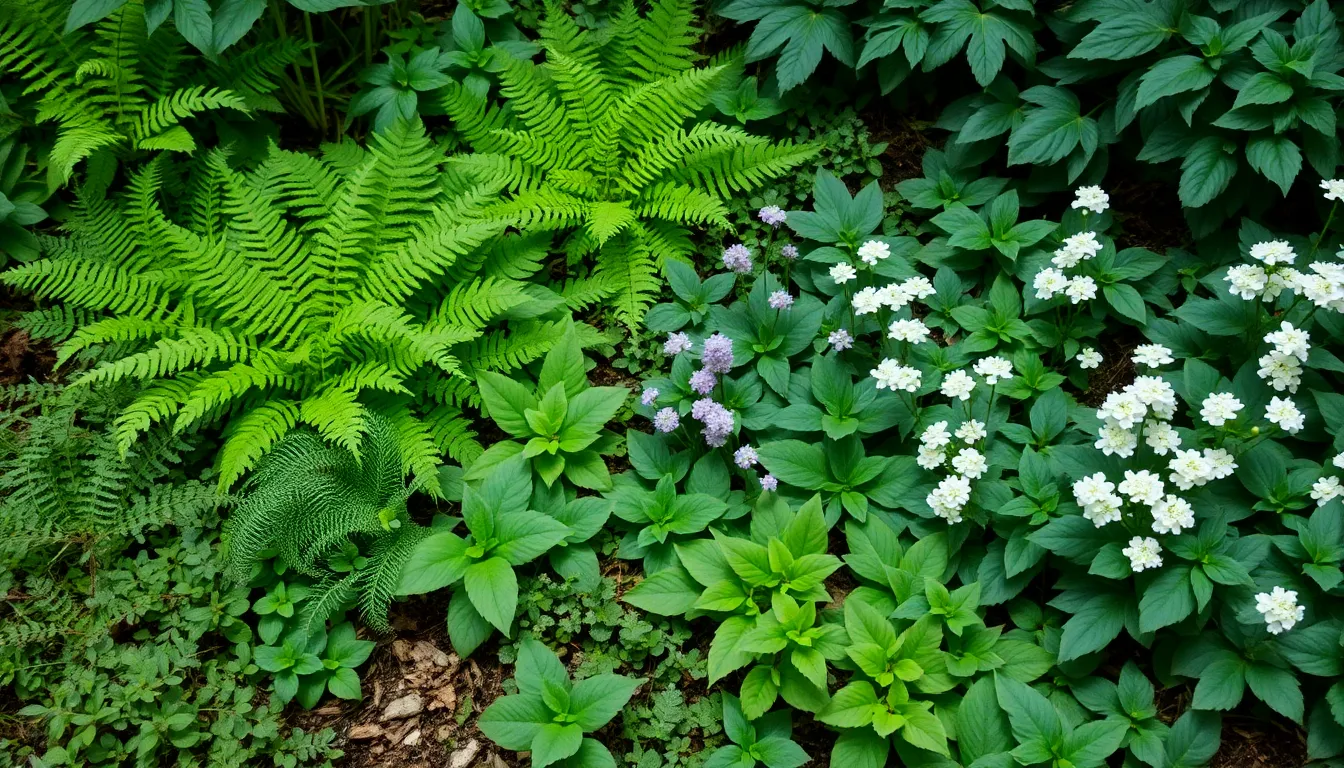
Selecting the perfect ground cover plants for your shade garden requires careful consideration of site conditions and plant characteristics. We’ll guide you through the essential steps to create a thriving, low-maintenance shaded industry.
Soil Testing and Site Assessment
Testing your soil before planting ensures your ground cover plants thrive in their new environment. We recommend checking soil moisture levels, pH balance, texture, and nutrient content to match plants with optimal growing conditions.
Sweet woodruff demonstrates why soil assessment matters, as it prefers acidic to neutral soil with a pH range of 5.5 to 7. Moisture levels play a crucial role since many shade ground covers like sweet woodruff require consistent moisture and fertile soil conditions to establish successfully.
Understanding your site’s exact drainage patterns helps prevent common problems like root rot or drought stress. We suggest observing how water behaves in your shaded areas during different seasons, noting areas that stay soggy versus those that dry out quickly.
Light levels vary significantly even within shaded spaces, from deep shade under dense canopies to dappled shade beneath high branches. Measuring these variations throughout the day helps us select plants that match each microclimate’s unique requirements.
Combining Multiple Species for Layered Interest
Creating ever-changing shade gardens involves mixing ground covers with different textures, foliage colors, and bloom times for continuous visual appeal. We achieve this layered effect by combining low-growing ferns with grassy Carex, fragrant sweet woodruff, and classic hostas for a cohesive yet varied industry.
Texture combinations work best when we pair plants with contrasting leaf shapes and growth habits. Hardy ferns provide delicate, feathery texture alongside the broad leaves of hostas, while evergreen Carex adds vertical interest with its grass-like appearance.
Seasonal interest extends throughout the year when we select plants with different bloom periods and foliage changes. Sweet woodruff produces white flowers in early summer, while variegated Carex forms maintain color through winter months.
Biodiversity improves when we layer multiple species, creating better weed suppression and continuous coverage across seasons. This approach reduces maintenance requirements since different plants support each other’s growth and create natural competition against unwanted weeds.
Ground preparation becomes simpler with mixed plantings since various root systems work together to improve soil structure and moisture retention. We find that combining shallow-rooted plants like Baby’s Tears with deeper-rooted species creates optimal growing conditions for the entire planting area.
Conclusion
We’ve explored many ground cover options that can transform your shaded garden areas from neglected spaces into thriving landscapes. From the colorful carpets of Ajuga to the evergreen reliability of Pachysandra and the aromatic charm of Sweet Woodruff these plants offer practical answers for challenging low-light conditions.
Success with shade ground covers comes down to understanding your exact site conditions and choosing plants that match your garden’s unique needs. Whether you’re dealing with dry shade under mature trees or moist areas along north-facing walls there’s a ground cover combination that’ll work perfectly for your space.
Remember that creating a beautiful shade garden isn’t just about covering bare soil – it’s about building a sustainable network that supports local wildlife while reducing your maintenance workload. With the right plant selection and proper installation techniques you’ll enjoy years of low-maintenance beauty in those previously problematic shaded areas.
Frequently Asked Questions
What ground cover plants work best in shady areas?
The best shade ground covers include Ajuga, Pachysandra, Hostas, Wild Ginger, Lamium, Sweet Woodruff, Creeping Phlox, Vinca minor, and Coral Bells (Heuchera). These plants thrive in low-light conditions and create attractive carpets where traditional grass struggles to grow.
Why won’t regular grass grow in shaded areas?
Traditional grass requires 4-6 hours of direct sunlight daily to thrive. In shaded areas under trees or along north-facing walls, grass becomes thin and patchy due to insufficient light. Ground cover plants are specially adapted to low-light conditions and perform much better in these challenging spots.
How do ground cover plants help prevent weeds?
Ground cover plants suppress weeds by creating dense mats that block sunlight from reaching weed seeds. Their extensive root systems and foliage coverage act as natural barriers, significantly reducing unwanted growth and minimizing the need for herbicides or frequent weeding.
What are the maintenance requirements for shade ground covers?
Most shade ground covers require minimal maintenance once established. Basic care includes consistent watering during establishment, occasional pruning to control spread, and annual cleanup in early spring. They typically need less frequent care than traditional grass lawns.
Can I combine different ground cover plants together?
Yes, combining multiple ground cover species creates layered visual interest and improves biodiversity. Mix plants with different textures, colors, and bloom times like Hostas with Sweet Woodruff or Lamium with Pachysandra for dynamic, thriving shade gardens that support healthy growth.
How do I prepare soil for shade ground covers?
Start with soil testing to understand pH, drainage, and moisture levels. Most shade plants prefer well-drained, organic-rich soil. Amend heavy clay or sandy soils with compost, and ensure proper drainage to prevent root rot while maintaining consistent moisture.
Which ground covers spread quickly vs. slowly?
Fast-spreading options include Ajuga, Vinca minor, and Sweet Woodruff, ideal for covering large areas quickly. Slower growers like Hostas and Coral Bells work better for controlled spaces. Consider your garden size and timeline when selecting between rapid or gradual coverage.
Are shade ground covers suitable for all climate zones?
Different plants have varying hardiness ranges. Pachysandra thrives in zones 4-8, while Coral Bells adapt to zones 4-9. Wild Ginger works in zones 4-8, and Ajuga suits zones 3-9. Check your USDA zone and select plants accordingly for best results.







